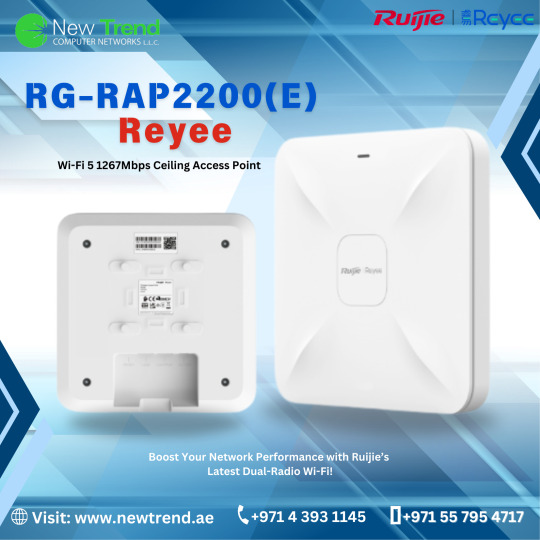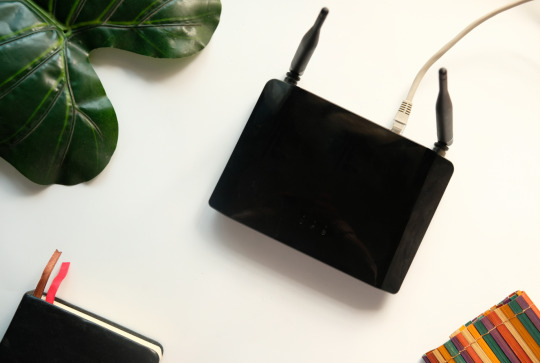#wifinetwork
Explore tagged Tumblr posts
Text





#netboon#OutdoorAntenna#5GAntenna#WiFiAntenna#HighGainAntenna#LPDAAntenna#WirelessConnectivity#OutdoorWirelessNetwork#5GNetwork#WiFiNetwork#WirelessInternet
0 notes
Text

RG-RAP2200(E) Reyee Wi-Fi 5 1267Mbps Ceiling Access Point
Highlight Features 1. Dual-radio performance, up to 1.267Gbps. 2. Get better performance with 802.11ac wave 2’s MU-MIMO technology. 3. Support to optimize the entire wireless network with just one click. 4. Easily set up your Wi-Fi network with Ruijie Cloud APP in 3 minutes. 5. With Ruijie Cloud, easy to maintain your networks remotely.
For more information, Visit: https://newtrend.ae/product-category/ruijie-ruijie-uae-partner/ 📞 Live chat: +971 507542792
#Ruijie#RG_RAP2200E#WiFi5#DualRadio#MU_MIMO#NetworkOptimization#RuijieCloud#RemoteManagement#WiFiPerformance#TechInnovation#FastInternet#NetworkingSolutions#CeilingAccessPoint#RuijieUAE#NetworkingMadeEasy#FastSetup#WiFiNetwork#NetworkSupport#TechForBusiness#UAEtech#WirelessSolutions
0 notes
Text

200 Mbps Super Fast Broadband
#wifi#instawifi#frewifi#wifihere#wifigratis#wifiaddict#wifipassword#wifilife#wifiproblems#wifispeed#wifisecurity#wifisignals#wifirouter#wifinetwork#wifibroadband#wifihotspot#wifionboard#travelwifi
0 notes
Text
How to Set Up a Home Wi-Fi Network for Optimal Performance
In today’s digital age, a stable and high-performing Wi-Fi network is essential for seamless internet connectivity and smooth communication. Whether you’re streaming videos, gaming, or working from home, setting up a home Wi-Fi network for optimal performance can make a significant difference in your online experience. In this comprehensive guide, we will walk you through the steps to create a…

View On WordPress
0 notes
Text
Intel Connectivity Analytics To Speed Up RF Troubleshooting

Troubleshoot Intel Connectivity Analytics Poor RF Issues Fast.
Employee productivity depends on Intel’s corporate wireless local area network (WLAN). Poor Radio Frequency (RF) conditions might cause users to become more frustrated and lose productivity. It has been discovered that proper access point (AP) placement, the outcome of efficient planning, is the first step towards dependable WLAN service. However, planning alone is insufficient to provide the network stability to want, as the recent white paper, “Optimizing and Troubleshooting Wi-Fi Networks Using Client Analytics,” explains.
Intel IT’s Best Practices for Avoiding Poor RF Issues
A few recommendations for optimal AP location have been established by Intel IT:
An AP should be placed every 45 feet.
In tiny meeting rooms, place an AP next to each of the four corners.
Install one access point (AP) for every eight users in bigger conference rooms.
Although these recommendations don’t always achieve the 99.999% coverage target, to estimate that they avoid poor RF coverage around 80% of the time. Internal walls, which can be made of concrete or cubicle panels, are hard to replicate. Additionally, the dynamic power level used by APs can vary based on how users are physically distributed around each AP.
The possibility of room layout changes between AP placement planning and installation is another issue. As a result, it go above and above to confirm that the installed APs offer the required coverage after a third-party company installs APs in accordance with the aforementioned rules.
Traditional RF Coverage Validation Is Time-consuming and Costly
There are two methods used to accomplish RF coverage validation:
To mimic coverage, use a commercial software program; until to actively update it, it might not precisely represent the floor layout.
Walk around the floor with a client device. This takes a lot of time, though, and not all colleges have IT personnel on staff.
It created an internal substitute for walking the floor a few years back as weren’t happy with any of these two solutions. AP power levels and user counts per AP are shown in a dashboard by the specialized software. With a high power level and a large user base, it can search for indications of limited coverage APs.
This internal software wasn’t perfect, though. It had to manually get data from the WLAN controller throughout the whole organization every five minutes. In order to exclude non-prime-time data, set intriguing values, and account for regional variations, this also had to create complex algorithms (for instance, Friday is a working day in some places but not in others). Such human efforts are almost unachievable with hundreds of thousands of APs placed worldwide.
This method of network certification wastes valuable IT resources and is not scalable.
A Faster, Better Approach to Validation
A more affordable and scalable method of network validation is Intel Connectivity Analytics, which was recently created in partnership with Cisco and Intel’s Client Computing group.
It could only collect AP data before utilizing Intel Connectivity Analytics; To had no insight into the client side of things. It could learn about the number of users and transmit power level (Tx) from AP data, but it only utilized these details as indicators of poor coverage. Direct measurement of the coverage from the client’s point of view was not feasible.
Intel Connectivity Analytics, on the other hand, continuously collects data from the actual client devices. The real client experience is reflected in the client data.Image Credit To Cisco Blogs
For any client utilizing Intel Wi-Fi hardware and linked to a compatible Cisco wireless network, this solution offers detailed driver-level wireless client information. The APs automatically gather the Wi-Fi telemetry that clients send and securely send it to a Cisco Meraki Cloud management platform, Cisco Catalyst controller, or Cisco Catalyst Center management platform. After processing the data, the system provides network managers with insightful reports.
An effective, focused method is offered by Intel Connectivity Analytics, which detects low Received Signal Strength Indicator (RSSI) occurrences to identify users who are having trouble with their radio frequency. By looking at the particular AP power level history and deployment, to may investigate the problem immediately without having to gather and examine a large quantity of data.
Drilling down reveals that all of the low RSSI occurrences on a given day originate from the same AP.
Note: A higher negative value indicates a weaker signal. RSSI is measured in decibel milliwatts (dBm). An RSSI of -70 dBm, for instance, is stronger than one of -85 dBm. A powerful signal has an RSSI of -50 dBm, whereas a very faint signal has an RSSI of -85.
In conclusion
It can rapidly identify low-coverage regions and determine the cause with Intel Connectivity Analytics. It removes the need to manually gather and examine RF data from the whole organization or to roam the floor. Only where it matters can now concentrate the efforts.
There is a significant time savings. It may take 10 to 15 minutes to troubleshoot a connectivity issue on the client side without Intel Connectivity Analytics, and the IT administrator could only resolve one client at a time. The mean time to repair has been reduced to 10–15 seconds with the Intel Connectivity Analytics, and the system may concurrently identify many broken connections.
It may take days to identify the root cause of a spate of connection difficulties with a network. It can now identify the underlying cause of an issue in a couple of seconds to the Intel Connectivity Analytics. Furthermore, to no longer need to develop internal custom scripts and automated processes for gathering and maintaining client data, nor do need to maintain the own tool.
Read more on Govidhtech.com
#IntelConnectivityAnalytics#ConnectivityAnalytics#Troubleshooting#RSSI#WLAN#accesspoint#WiFiNetworks#News#Technews#Technology#Technologynews#Technologytrends#Govindhtech
0 notes
Text
0 notes
Photo

Get Fast and Affordable Internet EarthLink knows the internet. It’s what our company was founded on more than 25 years ago. With HyperLink™ Internet, you can trust EarthLink to deliver reliable high speeds and best-in-class customer service, without the frustration of data caps. More Details Service Areas: United States #Earthlink #Wifinetwork #wifi #modem 👉 https://earthlink.pxf.io/kjQDxL https://www.instagram.com/p/CaA_7D6OJVt/?utm_medium=tumblr
0 notes
Photo

If you don’t get the internet speed you pay for, wireless internet router could be the reason! Browse: www.ealmihtig.com for more detailed information on ways to improve your WiFi Signal to enjoy faster speed. Download #Ealmihtig app now from android store for more details : https://rb.gy/kofx0v #technology #wifi #signal #wifistudy #signals #technologyblog #technics #blogger #internet #bloggers #wireless #network #wifinetwork #fiberoptic #router #ealmihtig (at Ahmedabad, India) https://www.instagram.com/p/CAs6iLPDyfC/?igshid=17ahib0eghmxz
#ealmihtig#technology#wifi#signal#wifistudy#signals#technologyblog#technics#blogger#internet#bloggers#wireless#network#wifinetwork#fiberoptic#router
0 notes
Link
0 notes
Text

Are you spending too much time sending a file to multiple devices? No more worries!
iTech Xpress is efficient in establishing and developing high-rated network services so that you can access files from any device.
We also provide top-branded networking products like LAN, WAN, and other wireless devices with one-time set-up and monthly maintenance service.
Call us for a secure network installation now!
Visit Our Website:- https://itechxpressinc.com/
0 notes
Link
If you just have one Chromecast streaming device, you need to have a WiFi connection for it to connect to your devices. However, Chromecast can only remember one network at a time. Therefore, if you want to use a different network, you will need to reset your Chromecast. Here’s how to change network settings on Chromecast in a number of different approaches.
0 notes
Link
Some of the useful tips for Securing Wi-Fi from Hackers are Change Your Router Admin Credentials, Create a Complicated Router Password, Turn on Wireless Network Encryption, Turn Off Your Wi-Fi Network When Not at Home, Limit WPS, etc.
0 notes
Photo

Rise of the invasive Signalcrayfish. @kristofferorum #kristofferørum #mixedmedia #3dprint #video #invasivespecies #networks #wifinetworks #scroolingscandinavia #digitalcurating #scandinavianart #nordicart #contemporaryart #nydanskkunst #kunst #konst #samtidskunst #samtidskonst #signalkrebs #signalcrayfish #wirelessinsurrection (her: Vejle Kunstmuseum) https://www.instagram.com/p/B8TI9BshjpA/?igshid=djpqlw5qx6m6
#kristofferørum#mixedmedia#3dprint#video#invasivespecies#networks#wifinetworks#scroolingscandinavia#digitalcurating#scandinavianart#nordicart#contemporaryart#nydanskkunst#kunst#konst#samtidskunst#samtidskonst#signalkrebs#signalcrayfish#wirelessinsurrection
0 notes
Text
Google Tips For Android Cross Device Services Sync Speedup

Learn how to enable fast hotspot and call sharing on Android devices. Apple Continuity-like connectivity across Android devices requires human activation.
Cross-device services
Google finally managed to make Android phones and tablets communicate and cooperate like Apple and Samsung devices after a long period. Cross-device services, which had been leaked for years, were announced in May, and just began operating for me a few days ago.
This cross device integration includes hotspot and calls. The concept is that your two phones may share an immediate hotspot or video chat without setup or passwords if they’re in the same Google account. The immediate hotspot won’t work with Samsung smartphones, but this should work with all Android phones, unlike Apple’s and Samsung’s solutions.
In my experience, Google’s Android-wide cross device implementation is quick and flawless.
Android Cross Device Services
Why cross-device integration important
In order to utilize the internet on a Wi-Fi-only Android tablet or other Android phone while out and about, you must first turn on the hotspot on your primary phone, then switch to the tablet. Before connecting, you must manually choose the tablet hotspot network and input the password the first time. hardly tedious, but hardly smooth, is it? Not when smart devices should communicate this knowledge behind the scenes. To prevent wasting your batteries, you must manually switch it off after use.
What if you could tether to a hotspot without touching or unlocking your primary phone?
Another obstacle is switching from a phone video conversation to a tablet or other bigger device. You must disconnect and rejoin the call or terminate and resume it on the other device. Nothing sensible or obvious about it.
Cross device connectivity enables neighboring phones and tablets talk in the background. Without touching or unlocking the primary phone or tablet, you may cast a video call or create a hotspot. Neat, huh?
Turning on cross-device services
Enable cross device services on all Android devices to benefit from this new integration (see screenshots for step-by-step instructions).
Google > Settings > All services > Cross device services
Install cross device services by tapping Next.
Tap Ok to combine devices under one Google account.
Then you’ll find cross-device service options like call casting and Internet sharing. Enable both if you want both functions, or disable one. You can also view all the account groups your device is part of (if you have numerous Google accounts on your phone like Mine do), all the devices in each group, and modify the name of your device in these groups.
Basically, done. To group your phones and tablets, repeat that on each. After that, cross device will appear automatically as required.
Joining a cross-device instant hotspot
Two techniques exist for your secondary phone or tablet to join an instant hotspot from your primary device. The first is an automated notice that appears when it unlock my offline phone near my connected phone.
The notice simply asks whether you’d like to utilize my primary phone’s hotspot, and pressing Connect connects me instantly (first three screenshots below). This works for data and Wi-Fi networks, although it’s always ideal to exchange the Wi-Fi network credentials with your secondary device and join directly. The primary phone will notify you that you’re sending data to another device (rightmost image below). When finished, press Disconnect on your secondary device’s notification and boom! When the hotspot ends, everything returns to normal.
You may manually scan the Wi-Fi networks and find your primary phone as an optional network at the top with a phone symbol if you don’t receive the automated notice, which is unusual for me. Tapping starts the immediate hotspot procedure.
Cast video calls to a second phone or tablet
The second feature of cross device services is the ability to transfer video calls across devices, such as your phone and tablet. To transmit a Google Meet video chat to other devices, hit the Cast symbol on the top right. A pop-up will invite you to do so. That list shows your neighboring devices, which you may choose.
After that, Meet opens immediately, launches the video call, and asks you to confirm the transfer. Select Switch to finish. You’re taking the call on your second device while your primary one displays a switchover alert.
Cross Platform Devices
Early signs of Apple-like Continuity and cross-platform connectivity
Personally utilizing these cross device tactics for the past several days while covering IFA in Berlin. Really love this new magic trick. My Pixel 9 Pro XL has a data connection thanks to EU-wide roaming, but my Pixel 9 Pro Fold doesn’t, which allows me to use the Fold to initiate an instant hotspot and turn it off when finished without touching or unlocking the Pro XL. Easy-peasy. But expect this to work just as well on a tablet without Wi-Fi. It can forget manual hotspots’ clunkiness.
This simplicity reminds me of Fast Pair. It now take it for granted when my earphones connect with my new Android phone or transition between devices. In the past, They had to manually match them.
Cross-device integration resembles Fast Pair: Smart, speedy, and smooth.
Cross device services operate seamlessly and make you wonder why we waited so long for them on vanilla Android. Better late than never, right? Some companies have their own Android skin, but exclusively on their phones. All Android users, particularly those who use different brands of phones and tablets, benefit from Google pushing it out.
Soon, hopefully phones and tablets will have cross device services enabled by default without special configuration. Part of the first phone setup.
Read more on Govindhtech.com
#Android#CrossDevice#Samsungdevices#Androidphones#Androidtablet#Androiddevices#WiFinetworks#Pixel9ProXL#news#Technology#technologynews#govindhtech
1 note
·
View note
Link
0 notes
Link

There are many benefits of using a home wireless network using wifi. A wireless network usually offers a less complicated installation, as the skills of wiring as well as electrical work could be limited, just enough to complete the installation of the wireless network and WiFi network setup. Call us today, 216.218-4204
0 notes